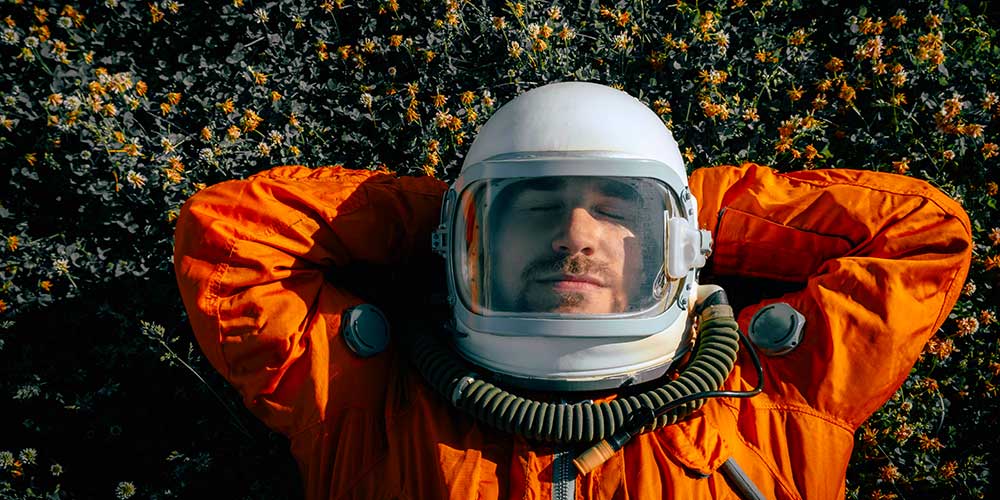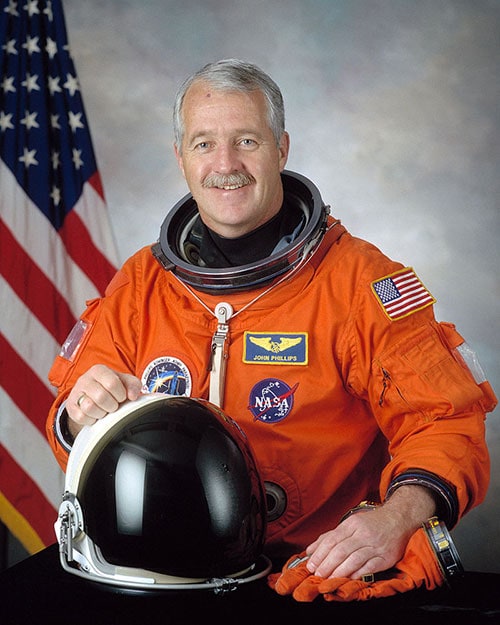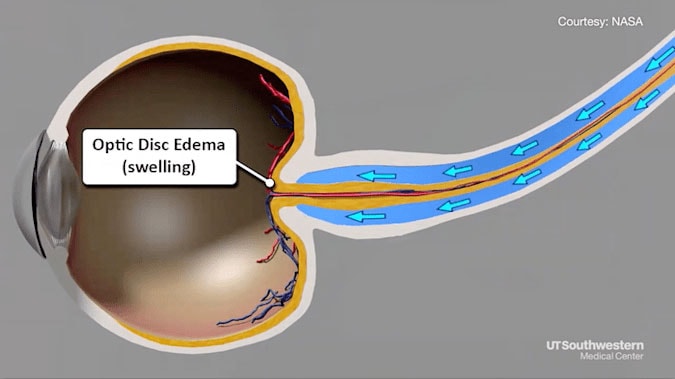
Like any challenging and largely unexplored frontier, spaceflight presents frequent surprises. Such as the surprising vision impairment suffered by astronaut John Phillips in 2005, about halfway through a six-month stint in the International Space Station (ISS).
Like all NASA astronauts, Phillips had 20/20 vision when he joined the space program. But, as reported by the BBC, after about three months in the microgravity of space, Phillips noticed that his view of Earth was becoming somewhat blurry. Sure enough, upon return to his home planet, Phillips’ post-flight physical showed that his vision had degraded from 20/20 to 20/100.
Flat eyeballs and swollen optic nerves

NASA took Phillips’ vision problems seriously. Top specialists from various fields put him through MRIs, retinal scans, neurological tests, and a spinal tap. All of those tests showed that not only was Phillips’ vision worse, he had been subjected to what ophthalmologists call “ocular remodeling.” His symptoms included flattening of the eyeballs and swelling of the optic nerves; his retinas were pushed forward, and he had choroidal folds, which are like stretch marks in the vascular tissue behind the retinas.
Returning to Earth did somewhat improve Phillips’ vision. After about six months back in the grip of Earth’s gravity, his eyesight improved from 20/100 to 20/50, and there it has stayed. As reported by the BBC, he must wear glasses to drive. But he wouldn’t trade his experience in space even for Superman’s X-ray vision.
What is space-associated neuro-ocular syndrome?
Phillips’ case was the first observation of what has come to be known as “space-associated neuro-ocular syndrome,” or SANS. A follow-up 2011 study involving seven ISS crew members revealed that, after six months or more at the space station, they each suffered some degree of blurry vision. Some reported that the ocular effects persisted for months after their return to Earth.
It has long been known that lying prone for lengthy periods, as one does while sleeping, causes blood to flow toward and into the head. Up to a half gallon of bodily fluid can collect in our heads during this process. This creates pressure on the brain and adjacent neurological systems, such as our vision apparatus. This pressure causes ocular remodeling and, perhaps, other neurological problems.
Doesn’t the pressure dissipate?
When we wake up on Earth, we stand up. And then we spend most of the day with our heads above our lower bodies. This allows Earth’s gravity to pull those fluids back down where they are supposed to be. The buildup of bodily fluids in the head and the accompanying pressure on adjacent systems is a temporary phenomenon. No problem.

But you can’t stand up in space. That’s because there is no “up” in space. As it turns out, the concepts of “up” and “down” are both derived solely from the effects of Earthly gravity. There is no gravity in space, so there is no mechanism to redistribute those bodily fluids.
On Earth, the pressure build-up in the cranium is relieved on a daily basis. But the lack of gravity in the ISS means that excess brain pressure persists for the duration of the astronaut’s tour of space duty.
And it’s likely that the problems caused by prolonged accumulation of bodily fluids in astronauts’ heads aren’t limited to just vision.
Ingenuity to the rescue: A special astronaut sleeping bag!
A team led by Dr. Benjamin Levine, a professor of internal medicine at the University of Texas (UT) Southwestern Medical Center, has been studying the array of problems presented by SANS for years. One of the difficulties they initially faced was devising a method of testing the theory that fluid builds up in the skull during spaceflight.
The only proven methods of measuring intracranial pressure are invasive: either a spinal tap or drilling a hole into the skull.
Levine’s team overcame this obstacle by finding volunteers with a pre-drilled hole in their skulls. They recruited volunteers who were also cancer survivors. They already had holes in their skulls: ports for receiving chemotherapy called Ommaya reservoirs. These pathways into the brain allowed direct measurement of pressure on the brain.
The volunteers were sent on zero-gravity airplane flights, passing through Earth’s upper atmosphere. Their brain pressure was measured using the chemotherapy ports.
How does an astronaut sleeping bag work?
In collaboration with the outdoor equipment retailer REI, Levine’s team next devised a high-tech sleeping bag.
The bag fits around the astronauts’ waists, enclosing their lower bodies within a solid frame. A built-in suction device, working on the same principle as a vacuum cleaner, creates a partial vacuum that draws fluid down toward the lower body. This process will, it is hoped, relieve the excessive pressure within the craniums of future astronauts.
The suction sleeping bag was tested by another set of volunteers
The participants lay on their backs for 72 straight hours. The pressure created was enough to alter the shape of their eyeballs. However, for eight hours each night, the volunteers’ lower bodies were placed into the new sleeping bags.
The study’s results, as published in the journal JAMA Ophthalmology, concluded that “[lower body negative pressure] during sleep may be an effective countermeasure for ocular remodeling and SANS during long-duration space travel.”
The age of astronauts is trending older, and thus vision problems are increasingly more likely. The duration of space missions is trending longer, with one of the upcoming ventures into outer space being a two-year Mars operation. NASA wants to make sure that its space adventurers can literally see what they’re doing, and it looks like a space-age lower body vacuum cleaner will help ensure that result.
Will space-associated neuro-ocular disorders cause other problems?
Levine says it’s unlikely that the problems caused by SANS are limited to vision. “It’s certainly possible that there are other effects of brain pressure we haven’t documented yet,” Levine said. ”The astronauts report something they call the ‘space stupids’. They make more mistakes than they think they should. Whether that has anything to do with the inability to lower the brain pressure, we don’t know.”
Why choose Assil Gaur Eye Institute for your eye care?
At AGEI, you will experience a state-of-the-art health care facility that brings together revolutionary technologies with experienced vision care professionals. Our goal is to help you achieve your personal best vision.
Please call 866-945-2745 or visit us here to make an appointment online. If you are experiencing any concerning symptoms, contact us immediately to determine the best time to schedule an exam.
At Assil Gaur Eye Institute we take our patients’ safety seriously. Our facility’s Covid-19 patient safety procedures exceed all CDC recommendations during the Covid pandemic. Masks are required in our institutes at all times.
We are conveniently located for patients throughout Southern California and the Los Angeles area at locations in or near Beverly Hills, Santa Monica, West Los Angeles, West Hollywood, Culver City, Hollywood, Venice, Marina del Rey, Malibu, Manhattan Beach, and Downtown Los Angeles.













